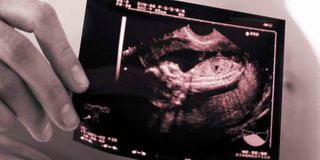Breaking News: Schools to reopen on Monday, Ruto announces
Towards AI-enabled ultrasound: Will Linda Mama absorb the cost?

A pregnant woman holding an ultrasound scan of her foetus in front of her swollen abdomen.
What you need to know:
- From studies, pregnant women in rural and arid and semi-arid areas like Garissa forgo this baby diagnostic scan because of the cost attached to it.
- The fact that they have to travel for more than 100km to reach hospitals.
More than one million women give birth in Kenya each year, yet ultrasound services are often limited to those with money and near health services.
From studies, pregnant women in rural and arid and semi-arid areas like Garissa forgo this baby diagnostic scan because of the cost attached to it, and the fact that they have to travel for more than 100km to reach hospitals.
Ultrasounds are important to help reduce the risk of stillbirths and pregnancy complications as well as give women a positive pregnancy experience, according to the World Health Organisation.
Sadly, only 64 per cent of women receive antenatal care, four or more times throughout their pregnancy, going by the global health body’s data.
In 2016, it released new guidelines on antenatal care, which increased antenatal visits from four to eight. It advised that the more the visits, the higher the chance of reducing perinatal deaths by up to eight per 1,000 births when compared to four visits.
It also guides women to have the first ultrasound scan before 24 weeks of pregnancy “to estimate gestational age, improve detection of foetal anomalies and multiple pregnancies, reduce induction of labour for post-term pregnancy, and improve a woman’s pregnancy experience”.
Linda Mama, a government-funded programme intended to reduce the maternal and neonatal mortality rates, however, excludes ultrasound costs in its 12-year inpatient and outpatient package for mother and newborn. This failure to fully invest in women’s health hurts a country’s economy.
Areport by the World Economic Forum says addressing the gaps in women’s health would potentially boost the global economy by at least $1 trillion annually by 2040.
There is hope. The world is making progress towards easing access to ultrasound services.
In September last year, Bill & Melinda Gates Foundation granted Chicago-based GE HealthCare more than $44 million to develop user-friendly, artificial intelligence (AI)-assisted ultrasound imaging auto-assessment tools.
“These tools will seek to aid healthcare professionals—even those without specialised training or experience with ultrasound—with clinical decision information to support more effective obstetric and lung screening ultrasound scans across maternal and foetal care as well as pediatric lung health,” the American multinational medical technology company writes on its website.
It says its goal is introducing the technology to low- and middle-income countries.
The philanthropic foundation’s financial support is immensely important to help close the gender health gap, as women’s health is little funded.
In Kenya, for instance, for the last three consecutive fiscal years, budgetary allocation to the Linda Mama programme has stagnated at Sh4.098 billion. Yet, annually, more women seek maternity services.
A 2022 report by the Office of the Auditor-General showed an increase in uptake of skilled maternal health services from 1,163,712 expectant mothers in 2020/21 to 1,186,004 in 2021/22.
“We’re excited to be working with partners who are developing new, portable tools powered by AI ultrasound technology that can be plugged into a cell phone or tablet.
"These tools can help support healthy pregnancies in every community,” the foundation says on its website.
Similarly, scientists are in the race to develop a monthly contraceptive pill, replacing those taken daily for 21 days.
Others are working on injectable contraceptives that last six months, up from three months.
While others are working on creating discreet microarray patches that would protect women from contracting HIV and getting pregnancy.





